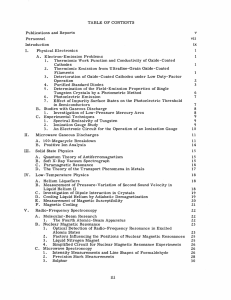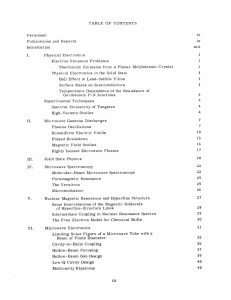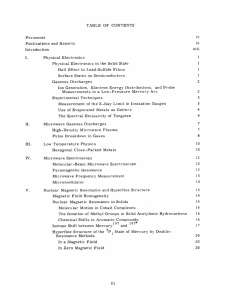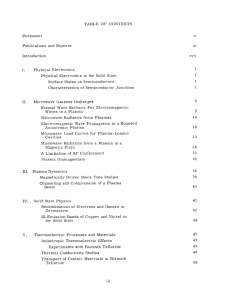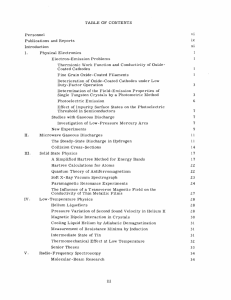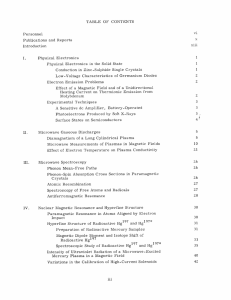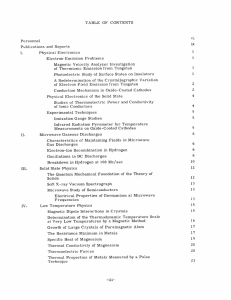XI. MICROWAVE DEVICES EMPLOYING MAGNETIC WAVES
advertisement
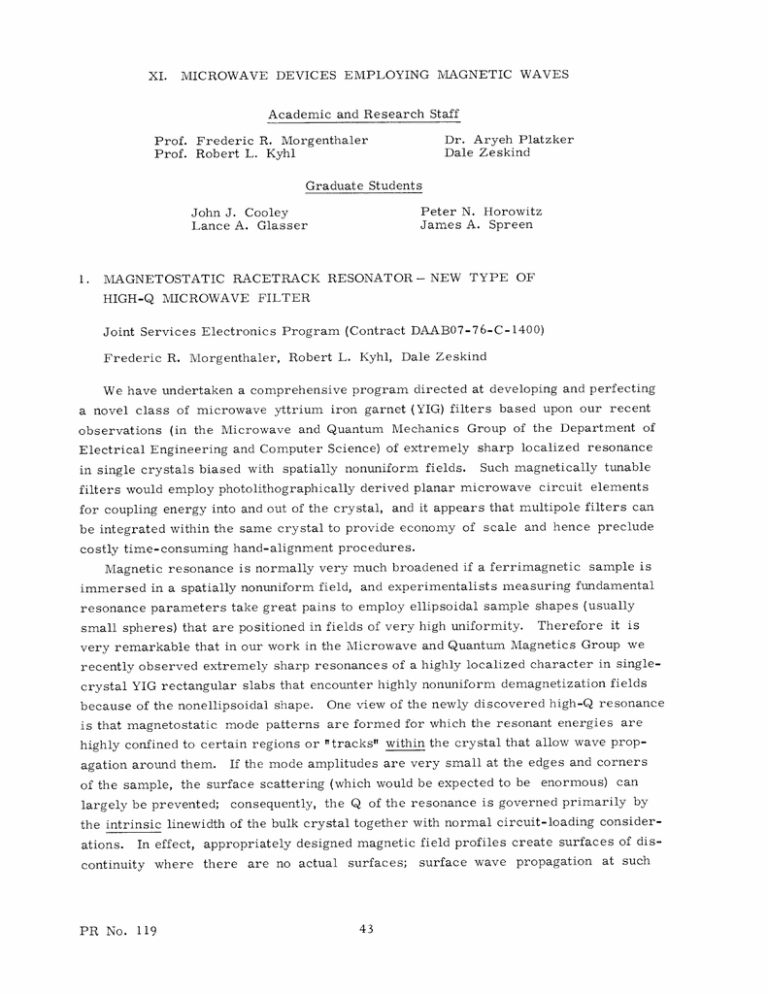
XI. MICROWAVE DEVICES EMPLOYING MAGNETIC WAVES Academic and Research Staff Prof. Frederic R. Morgenthaler Prof. Robert L. Kyhl Dr. Aryeh Platzker Dale Zeskind Graduate Students Peter N. Horowitz James A. Spreen John J. Cooley Lance A. Glasser 1. MAGNETOSTATIC RACETRACK RESONATOR -NEW HIGH-Q MICROWAVE TYPE OF FILTER Joint Services Electronics Program (Contract DAAB07-76-C-1400) Frederic R. Morgenthaler, Robert L. Kyhl, Dale Zeskind We have undertaken a comprehensive program directed at developing and perfecting a novel class of microwave yttrium iron garnet (YIG) filters based upon our recent observations (in the Microwave and Quantum Mechanics Group of the Department of Electrical Engineering and Computer Science) of extremely sharp localized resonance in single crystals biased with spatially nonuniform fields. Such magnetically tunable filters would employ photolithographically derived planar microwave circuit elements for coupling energy into and out of the crystal, and it appears that multipole filters can be integrated within the same crystal to provide economy of scale and hence preclude costly time-consuming hand-alignment procedures. Magnetic resonance is normally very much broadened if a ferrimagnetic sample is immersed in a spatially nonuniform field, and experimentalists measuring fundamental resonance parameters take great pains to employ ellipsoidal sample shapes (usually small spheres) that are positioned in fields of very high uniformity. Therefore it is very remarkable that in our work in the Microwave and Quantum Magnetics Group we recently observed extremely sharp resonances of a highly localized character in singlecrystal YIG rectangular slabs that encounter highly nonuniform demagnetization fields because of the nonellipsoidal shape. One view of the newly discovered high-Q resonance is that magnetostatic mode patterns are formed for which the resonant energies are highly confined to certain regions or agation around them. " tracks" within the crystal that allow wave prop- If the mode amplitudes are very small at the edges and corners of the sample, the surface scattering (which would be expected to be largely be prevented; enormous) can consequently, the Q of the resonance is governed primarily by the intrinsic linewidth of the bulk crystal together with normal circuit-loading considerations. In effect, appropriately designed magnetic field profiles create surfaces of discontinuity PR No. 119 where there are no actual surfaces; surface wave propagation at such (XI. MICROWAVE DEVICES EMPLOYING MAGNETIC WAVES) " surfaces" should be free of many of the drawbacks and loss mechanisms encountered at true surfaces. It is our intent to learn how to characterize, control, and efficiently couple to such modes so that we may create a new class of microwave magnetically tunable resonance filters. This research effort was motivated by observations reported by Dale Zeskind I of new spatially localized modes of ferromagnetic resonance in rectangular slabs of singlecrystal yttrium iron garnet (YIG), with dc magnetic field applied perpendicular to the plane of the slabs and microwave coupling provided between two closely spaced stripline antennas on the same surface of the YIG slab. With crystal dimensions of 0. 190" X 0. 161" X 0. 016" and antenna separation of 0. 0125" (antennas located along the center line of the slab) the resonance is characterized by a half-power bandwidth of 1. 8 MHz at 2. 5 GHz. The resonance center frequency is tunable over the range 2. 2-3. O0GHz by changing dc bias field magnitude. A hybrid stripline multiantenna device was constructed using microwave integrated circuit techniques. This device was used to plot the spatial distribution of the surface coupling phenomenon across the face of the crystal. Spatially localized points of reso- nance crystal exhibit symmetry about the occurring at the midplane. middle of the with maximum response Half-power spatial linewidths are approximately 0. 0025". A new sample holder with microstripline probes is being constructed and will be used in an attempt to provide definitive determinations of the high-Q mode distributions in existing crystals and in new crystals of both rectangular slab and circular disk geometries. We have also initiated a program of device synthesis aimed at tailoring modes with characteristics that are best suited to high-Q filter applications and will still allow reasonably efficient coupling to input and output circuits. Two separate methods of creating "tracks" to support and guide surfacelike magnetostatic waves of prespecified group velocity in YIG will be compared. In the first, spatially nonuniform magnetic fields of prespecified characteristics will be synthesized inside the crystal so as to form effective surfaces away from the actual crystal boundaries. In the second, they will be formed by mechanical means (i. e., etched grooves, slots, etc.) followed by argon ion beam milling to remove damaged surface layers. In both cases, control of the wave group velocities will be exercised so as to keep enough electromagnetic character to allow reasonable coupling efficiencies and still provide magnetostatic wavelength reductions and tunability, especially at lower microwave frequencies. Special emphasis is being given to creating modes that can constitute multisection filters of even higher selectivity and to configurations that will lend themselves to planar fabrication and integration techniques. We have already made substantial progress in determining PR No. 119 theoretically the (XI. MICROWAVE DEVICES EMPLOYING MAGNETIC WAVES) conditions necessary to cause a magnetostatic wave to be bound or confined by a dc magnetic field gradient located near the surface of a slab of ferrimagnetic crystal when the wave propagation is both parallel to the surface and perpendicular to the dc field direction. In the course of this investigation we have found a class of special dc field profiles that can bind magnetic waves having simple analytical properties characterized by closed-form expressions for mode pattern, group velocity, and the like. By proper choice of the gradient, the wave energy can be forced to occur either largely within or predominantly outside the crystal. Of equal importance is the fact that the bound wave frequencies and group velocities Therefore, in contrast with the can be gradient-controlled to a considerable extent. Damon-Eshbach surface mode propagating on a thick substrate with negligible speed, which in YIG must lie above 2. 5 GHz, frequencies can be made considerably lower and velocities much higher, if desired. When no boundary is present in the vicinity of the gradient region, bound waves can still exist but the transverse mode pattern is more complicated. We have also consid- ered situations in which the dc magnetic field profile is "well-shaped" with either positive or negative curvature, as required. References 1. D. A. Zeskind, "Localized Ferromagnetic Resonance in Non-uniform Magnetic Fields," S.M. and E.E. Thesis, Department of Electrical Engineering and Computer Science, M. I. T., February 1976; also available as Microwave and Quantum Magnetics Group Technical Report No. 36. 2. MICROWAVE DEVICES EMPLOYING CONTROLLED FOCUSING OF MAGNETOSTATIC WAVES Joint Services Electronics Program (Contract DAAB07-76-C-1400) Frederic R. Morgenthaler, Aryeh Platzker Our recently reported Platzker and Morgenthaler magnetic field synthesis procedurel has been utilized by 2 to construct a series of broadband, low-loss linearly dispersive magnetoelastic microwave delay lines that have yielded the highest levels of performance achieved with this class of device. The most striking features are the very broad instantaneous bandwidth, coupled with a very high degree of linearity of the delay time/frequency relation. These highly desirable features have been achieved without sacrifice of insertion loss, which remains relatively low and uniform across the operating frequency band. Although the synthesis to exacting standards of prespecified magnetic field profiles PR No. 119 (XI. MICROWAVE DEVICES EMPLOYING MAGNETIC WAVES) has made these achievements possible, it appears that extension to higher frequencies is feasible. Moreover, completely new types of linear and nonlinear filters can be developed, provided that proper control of focusing and defocusing characteristics of magnetostatic and/or magnetoelastic wave packets is exercised. Consequently, the Microwave and Quantum Magnetics Group of the Department of Electrical Engineering and Computer Science has initiated fundamental studies of controlled focusing. Experimentally, this has suddenly become feasible because of the magnetic field synthesis capability. In the undergraduate thesis research of Syed H. Nawab, now nearing completion, an improved synthesis procedure for creating a prespecified magnetic field profile H(z) inside a single-crystal YIG cylinder has been applied. In this case, the field necessary for operating a microwave magnetoelastic delay line has linear frequency dispersion over the 1-2 GHz frequency band. The measured characteristics of the synthesized device will be correlated with those expected from the theoretical model and the latter will be used to determine the actual dc field profile within the crystal. When this first phase is completed, we shall turn to the task of generating a special class of field profiles that have emerged from our analysis of magnetostatic wave focusing and defocusing. These "constant Q" profiles render the focusing parameter, 2HM 3 (H+M)2 (H+M)H"t (H') 2 independent of position. Here M is the saturation magnetization and H' and H" are the first and second derivatives of H with respect to z. We are particularly interested in the predicted range 0 <Q < 1 for providing optimum focusing. References i. F. R. Morgenthaler, "Synthesis of Cylindrically Symmetric Static Magnetic Fields in a Locally Saturated Ferromagnet," AIP Conference Proceedings No. 28, Magnetism and Magnetic Materials - 1974 (20th Annual Conference, San Francisco), pp. 503-504; available with greater detail as Microwave and Quantum Magnetics Group Technical Report No. 34, December 1974. 2. A. Platzker and F. R. Morgenthaler, "Synthesized Linearly Dispersive Microwave YIG Delay Line with Wide Instantaneous Bandwidth," AIP Conference Proceedings No. 29, Magnetism and Magnetic Materials - 1975 (21st Annual Conference, Philadelphia), pp. 645-64-6 PR No. 119
